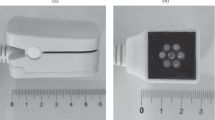Summary
Necrotic ulcers of the feet are a dangerous complication of the diabetic foot syndrome. Besides peripheral vascular disease (PVD) peripheral neuropathy is an important factor in the pathogenesis of necroses. We examined whether the reserve of circulation during reactive hyperemia at the feet of patients with type I diabetes mellitus with abnormal blood flow (n =17) is decreased compared with diabetic (n =14) and nondiabetic (n = 20) controls. Further we analyzed whether there is a correlation with the oxygen supply of the foot. PVD was excluded by clinical check-up, oscillography, and Doppler ultrasound. The reserve of circulation of the foot was measured during reactive hyperemia and oxygen supply of the foot by oximetry. Abnormal blood flow of the foot was diagnosed by the pulsation index. On examination it was found that the reserve of circulation of diabetic feet with abnormal blood flow is about 52% less than in diabetic and about 50% less than in nondiabetic controls (P<0.005). The decreased reserve of circulation correlates with the oxygen supply of the feet; this is about 21% less compared to diabetic feet with normal blood flow and about 16% less in comparison to nondiabetic feet. The present study shows that diabetic feet suffer from disturbed circulation although there is no evidence of PVD. This disturbed circulation is correlated with a decreased oxygen supply of the feet. Hypoxia during strain could be of great importance in the pathogenesis and treatment of necrotic ulcers of diabetic feet.
Similar content being viewed by others
Abbreviations
- PVD:
-
peripheral vascular disease
References
Boulton AJM, Scarpello JHB, Ward JD (1982) Venous oxygenation in the diabetic neuropathic foot: evidence of arteriovenous shunting? Diabetologia 22:6–8
Craig R, Wyss PD, Frederick A, Matsen MD, Simmons CW, Burgess BS (1984) Transcutaneous oxygen tension measurements on limbs of diabetic and nondiabetic patients with peripheral vascular disease. Surgery 90:339–345
Edmonds ME, Robert VC, Watkins PJ (1982) Blood flow in the diabetic foot. Diabetologia 22:9–15
Ewing DJ, Campbell IW, Clarke BF (1980) The natural history of diabetic autonomic neuropathy. Medicine 193:95–108
Gaylarde PM, Fonseca VA, Llewellyn G, Sarkany I, Dandona P (1988) Transcutaneous oxygen tension in legs and feet of diabetic patients. Diabetes 37:714–716
Haitas B, Barnes A, Shogry C, Wendling M, Rolffe P, Turner C (1984) Delayed vascular reactivity to ischemia in diabetic microangiopathy. Diabetes Care 7:47–51
Hauser KJ, Klein SR, Mehringer M, Appel P, Shoemaker WC (1984) Assessment of perfusion in the diabetic foot by regional transcutaneous oximetry. Diabetes 33:527–531
Hauser KJ, Stanley R, Klein MD, Mehringer M, Appel P, Shoemaker WC (1984) Superiority of transcutaneous oximetry in noninvasive vascular diagnosis in patients with diabetes. Arch Surg 119:690–694
Jorgensen R, Russo L, Mattioli L, Moore W (1988) Early detection of vascular dysfunction in type I diabetes. Diabetes 37:292–296
Modesti PA, Boddi M, Poggesi L, Gensini GF, Serneri GGN (1987) Transcutaneous oximetry in evaluation of the initial peripheral artery disease in diabetics. Angiology 38:457–462
Newrick PG, Cochrane T, Betts RP, Ward JD, Boulton AJM (1988) Reduced hyperemic response under the diabetic neuropathic foot. Diabetic Med 5:570–573
Railton R, Newman P, Hislop J, Harrower ADB (1983) Reduced transcutaneous oxygen tension and impaired vascular response in type I (insulin-dependent) diabetes. Diabetologia 25:340–342
Rendell M, Bergmann T, O'Donnell G, Borgos J, Bonner RF (1989) Microvascular blood flow, volume and velocity measured by laser Doppler techniques in IDDM. Diabetes 38:819–824
Rooke TW, Hollier L, Osmundson PJ (1987) The influence of sympathetic nerves on transcutaneous oxygen tension in normal and ischemic lower extremities. Angiology 38:400–410
Svedman P, Jacobsson S, Lindell SE, Ponnert L (1978) Measurement of transcutaneous oxygen tension: a method for studying the blood supply to the skin. J Med Sci 6:339
Vlassara H, Brownlee M, Cerami A (1986) Nonenzymatic glycosilation role in the pathogenesis of diabetic complications. Clin Chem 32B:37–41
Vogelberg, KH, Storck W (1988) Measurement of pulse reappearance time in diagnosis of peripheral vascular disease in diabetes. Diabetes Care 11:345–350
Vogelberg KH, Mayer P, König M (1990) Decrease of macrovascular hyperemic response of blood flow in diabetics with arterial neuropathy. Klin Wochenschr 68:588–593
Author information
Authors and Affiliations
Rights and permissions
About this article
Cite this article
Vogelberg, K.H., König, M. Hypoxia of diabetic feet with abnormal arterial blood flow. Clin Investig 71, 466–470 (1993). https://doi.org/10.1007/BF00180061
Received:
Revised:
Accepted:
Issue Date:
DOI: https://doi.org/10.1007/BF00180061




